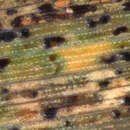mk
имиња во трошки


Puccinia fragosoi ist eine Ständerpilzart aus der Ordnung der Rostpilze (Pucciniales). Der Pilz ist ein Endoparasit von Lauche und Schillergräser. Symptome des Befalls durch die Art sind gelbe Rostflecken und Pusteln auf den Blattoberflächen der Wirtspflanzen. Das Verbreitungsgebiet umfasst weite Teile Europas.
Puccinia fragosoi ist mit bloßem Auge nur anhand der auf der Oberfläche des Wirtes hervortretenden Sporenlagern zu erkennen. Sie wachsen in Nestern, die als gelbliche bis braune Flecken und Pusteln auf den Blattoberflächen erscheinen.
Das Myzel von Puccinia fragosoi wächst wie bei allen Puccinia-Arten interzellulär und bildet Saugfäden, die in das Speichergewebe des Wirtes wachsen. Ihre Pyknien sind honigfarben bis braunrötlich und wachsen auf beiden Blattseiten. Die Aecien sind klein, becherförmig und orange. Sie besitzen eckige Aecidiosporen von 22–30 × 18–20 µm, die hyalin und fein warzig sind. Die Uredien wachsen meist blattoberseitig und sind gelbbraun. Ihre Uredosporen sind erst kugelig, später ei- oder birnenförmig, 19–34 × 19–34 µm groß und warzig. Die blattunterseitig wachsenden Telien der Art sind ellipsoid bis länglich und schwarz. Die Teleutosporen sind ein- bis zweizellig, länglich bis keulenförmig und 30–75 × 13–22 µm groß. Sie sind braun, ihr Stiel ist 10–20 µm lang und gelbbraun.
Puccinia fragosoi besitzt ein Verbreitungsgebiet, das sich über weite Teile Europas erstreckt.
Die Wirtspflanzen von Puccinia fragosoi sind als Haplont Lauche (Allium spp.) sowie Schillergräser (Koeleria spp.) für den Dikaryonten. Der Pilz ernährt sich von den im Speichergewebe der Pflanzen vorhandenen Nährstoffen, seine Sporenlager brechen später durch die Blattoberfläche und setzen Sporen frei. Die Art verfügt über einen Entwicklungszyklus mit Pyknien, Uredien, Telien und Aecidien.
Puccinia fragosoi ist eine Ständerpilzart aus der Ordnung der Rostpilze (Pucciniales). Der Pilz ist ein Endoparasit von Lauche und Schillergräser. Symptome des Befalls durch die Art sind gelbe Rostflecken und Pusteln auf den Blattoberflächen der Wirtspflanzen. Das Verbreitungsgebiet umfasst weite Teile Europas.
Puccinia hordei is a species of rust fungus. A plant pathogen, it can cause leaf rust of barley, also known as brown rust of barley.[2][3]
At the time of Johnston et al., 2013's discovery of severe susceptibility in Golden Promise, this was considered to be the most susceptible variety in the world.[3] Soon thereafter however, Yeo et al., 2014 found SusPtrit was slightly worse.[3] These results alter the meaning of such a basic term as "fully susceptible" to brown rust.[3]
Puccinia hordei is a species of rust fungus. A plant pathogen, it can cause leaf rust of barley, also known as brown rust of barley.
At the time of Johnston et al., 2013's discovery of severe susceptibility in Golden Promise, this was considered to be the most susceptible variety in the world. Soon thereafter however, Yeo et al., 2014 found SusPtrit was slightly worse. These results alter the meaning of such a basic term as "fully susceptible" to brown rust.
Puccinia hordei est une espèce de champignons basidiomycètes de la famille des Pucciniaceae.
Ce champignon phytopathogène est l'agent responsable de la rouille naine de l'orge.
Selon Catalogue of Life (16 novembre 2015)[1] :
Puccinia hordei est une espèce de champignons basidiomycètes de la famille des Pucciniaceae.
Ce champignon phytopathogène est l'agent responsable de la rouille naine de l'orge.
Puccinia hordei G.H. Otth – gatunek grzybów z rodziny rdzowatych (Pucciniaceae)[1]. U jęczmienia wywołuje chorobę zwaną rdzą jęczmienia. Puccinia hordei jest szeroko rozprzestrzeniona we wszystkich rejonach uprawy jęczmienia na świecie[2].
Pozycja w klasyfikacji według Index Fungorum: Puccinia, Pucciniaceae, Pucciniales, Incertae sedis, Pucciniomycetes, Pucciniomycotina, Basidiomycota, Fungi[1].
Puccinia hordei jest pasożytem dwudomowym, znaczy to, że jej rozwój odbywa się na dwóch różnych żywicielach. Jest też pasożytem obligatoryjnym, czyli może rozwijać się tylko na żywych organizmach i rdzą pełnocyklową – wytwarza wszystkie typowe dla rdzy rodzaje zarodników[2].
Żywicielami ecjalnymi są różne gatunki z rodzaju śniedek (Ornithogalum), Leopoldia i Dipcadi. Powstają na nich spermogonia wytwarzające spermacja i ecja wytwarzające ecjospory. Rozsiewane przez wiatr ecjospory dokonują na jęczmieniu infekcji pierwotnej. Przy sprzyjającej pogodzie już po 8 dniach na liściach jęczmienia z ecjospor rozwijają się strzępki tworzące uredinia z urediniosporami, które rozsiewane przez wiatr dokonują infekcji wtórnej rozprzestrzeniając chorobę. Nieco później powstają telia wytwarzające teliospory będące przetrwalnikami. Z teliospor powstaje przedgrzybnia wytwarzająca bazydiospory infekujące żywiciela ecjalnego[2].
W Polsce i w Europie Środkowej bardzo rzadko jednak występuje taki pełny cykl rozwojowy, zazwyczaj cały rozwój patogena odbywa się tylko na jęczmieniu[2].
Spermacja i ecja wytwarzane są na blaszce liściowej żywiciela ecjalnego. Ecjospory mają rozmiar 25-29,5 × 21-24,5 μm i ścianę o grubości 1 μm pokrytą dwoma rodzajami brodawek; o wysokości 0,5-0,8 μm lub 0,2-0,4 μm, gęsto stłoczonymi, lub rozmieszczonymi w odległościach 0,4-0,8 μm. Małe brodawki zwykle tworzą niewielkie grupy[4].
Uredinia mają wielkość do 0,3 mm, są nagie, jasno-brązowo-żółtawe. Eliptyczne lub odwrotnie jajowate urediniospory mają rozmiar 23-30 (-33) × 18-25 μm. Ściana o grubości 1,0-1,7 (-2,0) μm, jej warstwa zewnętrzna jest blada żółta, cienka warstwa wewnętrzna jest żółto-brązowa. Pokryta jest kolcami o rozmiarach (0,3-) 0,5-0,8 (-1,0) μm. Między kolcami znajduje się (6) 7-11 (-13) zazwyczaj odrębnych porów rostkowych[4].
Telia powstają tylko na dolnej stronie blaszki liściowej jęczmienia, są czarne i nieco większe od urediniów. Wstawki o barwie od pomarańczowo-brązowej do kasztanowatej i długości 60-70 (-80) μm[4]. Teliospory dwukomórkowe o kształcie maczugowatym i nieregularnym, o szczycie nieco nieco spłaszczonym, zaokrąglonym lub zaostrzonym i barwie żółtobrunatnej. Mają cienkościenne boki i zgrubiałe szczyty. Oprócz typowych teliospor powstają w teliach także jednokomórkowe mezospory o kształcie eliptycznym, maczugowatym lub odwrotnie jajowatym[2].
Puccinia hordei G.H. Otth – gatunek grzybów z rodziny rdzowatych (Pucciniaceae). U jęczmienia wywołuje chorobę zwaną rdzą jęczmienia. Puccinia hordei jest szeroko rozprzestrzeniona we wszystkich rejonach uprawy jęczmienia na świecie.
Puccinia hordei je grzib[24], co go ôpisoł G.H. Otth 1871. Puccinia hordei nŏleży do zorty Puccinia i familije Pucciniaceae.[25][26] Żŏdne podgatōnki niy sōm wymianowane we Catalogue of Life.[25]
Puccinia hordei je grzib, co go ôpisoł G.H. Otth 1871. Puccinia hordei nŏleży do zorty Puccinia i familije Pucciniaceae. Żŏdne podgatōnki niy sōm wymianowane we Catalogue of Life.